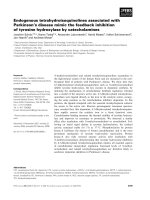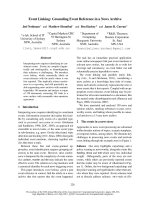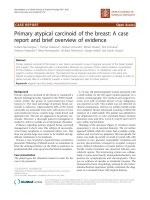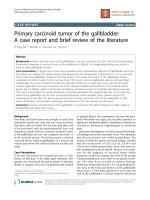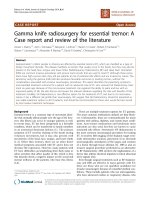Báo cáo khoa hoc:" Anaphylactic reaction associated with Ranitidine in a patient with acute pancreatitis: a case report" pdf
Bạn đang xem bản rút gọn của tài liệu. Xem và tải ngay bản đầy đủ của tài liệu tại đây (176.87 KB, 2 trang )
BioMed Central
Page 1 of 2
(page number not for citation purposes)
Journal of Medical Case Reports
Open Access
Case report
Anaphylactic reaction associated with Ranitidine in a patient with
acute pancreatitis: a case report
Ulfin Rethnam* and Rajam Sheeja Yesupalan
Address: Department of Orthopaedics, Glan Clwyd Hospital, Rhyl, UK
Email: Ulfin Rethnam* - ; Rajam Sheeja Yesupalan -
* Corresponding author
Abstract
: Ranitidine is a widely used drug and is known to be well tolerated. This case report illustrates a
severe anaphylactic reaction after a single intravenous dose of 50 mgs of ranitidine and highlights
this unusual but life threatening adverse reaction.
The patient: A 56 year old female with acute pancreatitis and a known allergy to metronidazole
and buscopan developed an anaphylaxis few minutes following the injection of ranitidine for
epigastric discomfort. She went on to develop anaphylactic shock and a cardiorespiratory arrest.
Management: She was managed with adrenaline, hydrocortisone and ventilatory support
following which she had a full recovery.
Conclusion: Awareness of this rare but life threatening adverse reaction to a commonly used drug
can avoid being caught unaware.
Background
Ranitidine is a widely used H2 receptor antagonist and is
usually well tolerated by patients. Being considered a safe
drug, ranitidine is available over the counter all over the
world. It is a drug commonly administered in the Acci-
dents & Emergency. Anaphylactic reaction to ranitidine is
rare. This life-threatening adverse reaction can take the cli-
nician by surprise.
This case report highlights the occurrence of this rare but
dangerous adverse reaction to ranitidine.
Case presentation
A 56-year-old female with acute pancreatitis was admitted
under our care. She was known to suffer from diverticular
disease and had a myocardial infarction in the past. She
was allergic to metronidazole and buscopan. She had no
family history of drug allergies.
During the initial course of management she was given 50
mg of ranitidine as a slow intravenous bolus for epigastric
discomfort. Few minutes after the injection, the patient
complained of itching at the injection site that spread to
involve the entire upper limb. She also complained of
swelling of her tongue and difficulty in breathing. Within
minutes her level of consciousness deteriorated and she
became comatose. The initial examination revealed the
following features: GCS 6/15, a grossly oedematous face,
neck and extremities, a grossly swollen tongue, congested
conjunctivae, cyanosis, diffuse rhonchi over both lung
fields.
Published: 31 August 2007
Journal of Medical Case Reports 2007, 1:75 doi:10.1186/1752-1947-1-75
Received: 21 December 2006
Accepted: 31 August 2007
This article is available from: />© 2007 Rethnam and Yesupalan; licensee BioMed Central Ltd.
This is an Open Access article distributed under the terms of the Creative Commons Attribution License ( />),
which permits unrestricted use, distribution, and reproduction in any medium, provided the original work is properly cited.
Publish with BioMed Central and every
scientist can read your work free of charge
"BioMed Central will be the most significant development for
disseminating the results of biomedical research in our lifetime."
Sir Paul Nurse, Cancer Research UK
Your research papers will be:
available free of charge to the entire biomedical community
peer reviewed and published immediately upon acceptance
cited in PubMed and archived on PubMed Central
yours — you keep the copyright
Submit your manuscript here:
/>BioMedcentral
Journal of Medical Case Reports 2007, 1:75 />Page 2 of 2
(page number not for citation purposes)
Despite immediate administration of intramuscular
adrenaline, intravenous hydrocortisone and high flow
oxygen the patient progressed into a cardio respiratory
arrest. Cardiopulmonary resuscitation was commenced.
Patient was intubated with difficulty and was resuscitated
successfully. She was transferred to the Intensive Care
Unit for ventilatory and inotropic support. Two days later
she was weaned off the ventilator and by then she was
haemodynamically stable without inotropic support. She
made a full recovery in 3 days. A skin sensitivity test prior
to the patient's discharge revealed the patient's sensitivity
to Ranitidine.
Discussion
Ranitidine is a H2 receptor antagonist widely used for acid
peptic disease and usually well tolerated. Anaphylactic
reaction to ranitidine is rare and only a few cases have
been reported in the literature. Most of the patients
reported were obstetric patients.[1-3] In our review of lit-
erature there have been no report of severe anaphylaxis to
ranitidine in a patient with pancreatitis. Demirkan et al
found only 2 cases of anaphylactic reaction due to raniti-
dine of 8304 first referral patients over a 13 year period.
[4] The incidence of anaphylactic reaction to H2 receptor
antagonists and proton pump inhibitors together has
been reported as 0.3% – 0.7%. [5] We could not find any
association between allergies to metronidazole and
buscopan and the development of an anaphylactic reac-
tion to ranitidine.
The anaphylactic reaction in our patient was due to raniti-
dine as she developed signs of anaphylaxis a few minutes
after receiving the intravenous dose the drug. She was not
given any other medication prior to ranitidine. The man-
agement was directed towards combating the severe ana-
phylactic reaction. All the cases reported in literature were
treated along the same lines. No mechanisms have been
identified for this adverse reaction. As the patient was
known to be allergic to other medications, this may sug-
gest that allergy to ranitidine may develop in patients with
known multiple allergies.
This type of a reaction to a commonly used drug like ran-
itidine can take the clinician by surprise. Although the
management for this is to treat the anaphylaxis, it is
important that the clinician is aware of this adverse reac-
tion.
Conclusion
This case report was prepared to highlight a rare and unu-
sual adverse reaction to a widely used drug, ranitidine.
Caution needs to be exercised on intravenous administra-
tion of this drug as the physician can be caught unaware.
Competing interests
The author(s) declare that they have no competing inter-
ests.
Authors' contributions
UR was involved in collecting patient details, reviewing
the literature and drafted the manuscript as the main
author. RSY was involved in reviewing the literature and
proof reading of the manuscript. RSY has approved the
final manuscript. All authors have read and approved the
final manuscript.
Acknowledgements
Consent was obtained from the patient for publication of study. Funding
was neither sought nor obtained.
References
1. Powell JA, Maycock EJ: Anaphylactoid reaction to ranitidine in
an obstetric patient. Anaesth Intensive Care 1993, 21(5):702-3.
2. Barry JE, Madan R, Hewitt PB: Anaphylactoid reaction to raniti-
dine in an obstetric patient. Anaesthesia 1992, 47(4):360-1.
3. Greer IA, Fellows K: Anaphylactoid reaction to ranitidine in
labour. Br J Clin Pract 1990, 44(2):78.
4. Natsch S, Vinkins MH, Voogt AK, Mees EB, Meyboom RHB: Anaphy-
lactic reactions to proton-pump inhibitors. Ann Pharmacother
2000, 34:474-6.
5. Demirkan K, Bozkurt B, Karakaya G, Kalyoncu AF: Anaphylactic
Reaction to Drugs Commonly Used for Gastrointestinal Sys-
tem Diseases: 3 Case Reports and Review of the Literature.
J Investig Allergol Clin Immunol 2006, 16(3):203-209.

